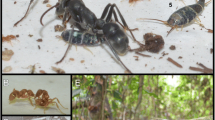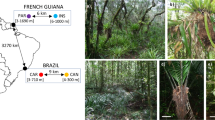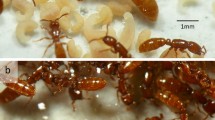Abstract
In the savanna-like Brazilian biome “caatinga,“ the arboreal and polydomous ant Crematogaster brevispinosa rochai can be found cohabiting with two closely related Nasutitermes species (N. corniger and N. ephratae). This ant occupies variably sized portions of the termite nests and maintains a physical separation with its hosts by plugging the cells of the boundary areas with fibrous material. Although all the analysed cohabiting C. b. rochai nests were queenless, they always contained brood, especially from male and female reproductive castes. Interaction experiments between workers of C. b. rochai and workers or soldiers of N. ephratae revealed a low level of aggressiveness between the two species that contrasts with the aggressiveness of both C. b. rochai and N. ephratae in encounters with other ant (Azteca cf. chartifex, Cephalotes pusillus) or termite (M. cf. indistinctus) species. The association could benefit both ants (additional nesting sites, brood rearing places) and termites (protection against predators, dead ants or ant refuses as source of nitrogen).
Similar content being viewed by others
References
Bolton, B. (1995a). A New General Catalogue of the Ants of the World, Harvard University Press, Cambridge, Massachusetts.
Bolton, B. (1995b). A taxonomic and zoogeographical census of the extant ant taxa (Hymenoptera: Formicidae). J. Nat. Hist. 29: 1037–1056.
Braekman, J. C., Daloze, D., Dupont, A., Pasteels, J. M., Lefeuve, P., Borderau, C., Declercq, J. P., and Van Meerssche, M. (1983). Chemical composition of the frontal gland secretion from soldiers of Nasutitermes lujae (Termitidae: Nasutermitinae). Tetrahedron 39: 4237–4241.
Bugnion, E. (1927). The origin of instinct, a study of the war between the ants and the termites. Monographs No. 1, Londres.
Darlington, J. P. E. C. (1985). Attacks by Doryline ants and termites nest defences (Hymenoptera: Formicinae, Isoptera: Termitidae). Sociobiology 11: 189–200.
Dejean, A., and Fénéron, R. (1999). Predatory behaviour in the ponerine ant, Centromyrmex bequaerti: A case of termitolesty. Behav. Processes 47: 125–133.
Delabie, J. H. C. (1995). Inquilinismo simultâneo de duas espécies de Centromyrmex (Hymenoptera: Formicinae: Ponerinae) em cupinzeiros de Syntermes sp. (Isoptera: Termitidae: Nasutiterminae). Revta Bras. Ent. 39: 605–609.
Deligne, J., Quennedey, A., and Blum, M. S. (1981). The enemies and defense mechanisms of termites. In Hermann, H. R. (ed.), Social Insects. Volume II, Academic Press, New York, pp. 1–76.
Eggleton, P. (2000). Global patterns of termite diversity. In Abe, T., (eds.), Termites: Evolution, Sociality, Symbioses, Ecology, Kluwer Academic Publishers, pp. 25–51.
Gray, B. (1974). Associated fauna found in nest of Myrmecia (Hymenoptera: Formicidae). Insectes Sociaux 21: 289–300.
Hervier, B., Josens, G., Deligne, J., Terwinghe, E., and Verbanck, J. (2001). Etudes des structures internes des nids de termites par analyse d’image. Actes Coll. Insectes Sociaux. 14: 45–49.
Higashi, S., and Ito, F. (1989). Defense of termitaria by termitophilous ants. Oecologia 80: 145–147.
Hölldobler, B., and Wilson, E. G. (1990). The Ants, Springer-Verlag, Berlin.
Howard, R. W., Me Daniel, C. A., and Blomquist, G. J. (1980). Chemical chemistry as an integrating mechanism: cuticular hydrocarbons of a termitophile and its host. Science 210: 431–433.
Jaffe, K., Ramos, C., and Issa, S. (1995). Trophic interactions between ants and termites that share common nests. Ann. Entomol. Soc. Amer. 88: 328–333.
Kambhampati, S., and Eggleton, P. (2000). Taxonomy and phylogeny of termites. In Abe, T., (eds.), Termites: Evolution, Sociality, Symbioses, Ecology, Kluwer Academic Publishers, pp. 1–23.
Leclercq, S., Braekman, J. C., Daloze, D., de Biseau, J. C., Pasteels, J. M., Quinet, Y., Luhmer, M., and Sundin, A. (2000). Furanocembrenoid Diterpenes as Defensive Compounds in the Dufour’s Gland of the Ant Crematogaster brevispinosa rochai. Tetrahedron 56: 2037–2042.
Lemaire, M., Lange, C., Lefevre, J., and Clement, J.-L. (1986). Strategie de camouflage du prédateur Hypoponera eduardi dans les sociétés de Reticuliternies européens. Actes Coll. Insectes Sociaux. 2: 97–101.
Lenoir, A., D’ettore, P., Errard, C., and Hefetz, A. (2001). Chemical ecology and social parasitism in ants. Ann. Rev. Entomol. 46: 573–599.
Lepage, M. G. (1981). Etude de la prédation de Megaponera foetens sur les populations récoltantes de Macrotermitinae dans un écosystème semi-aride (Kajiado—Kenya). Insectes Sociaux 28: 247–262.
Leponce, M., Roisin, Y., and Pasteels, J. M. (1999). Community interactions betweens ants and arboreal-nesting termites in New Guinea coconut plantations. Insectes Sociaux 46: 126–130.
Longhurst, C., Johnson, R. A., and Wood, T. G. (1978). Predation by Megaponerafoetens (Fabr.) (Hymenoptera: Formicidae) on termites in the southern Guinea savanna, Nigeria. Oecologia 32: 101–107.
Longhurst, C., Johnson, R. A., and Wood, T. G. (1979). Foraging, recruitment and predation by Decamorium nelense (Santchi) (Formicidae: Myrmicinae) on termites in the southern Guinea savanna, Nigeria. Oecologia 38: 83–91.
Longino, J. T. (2003). The Crematogaster (Hymenoptera, Formicidae, Myrmicinae) of Costa Rica. Zootaxa 151: 1–150.
de Marneffe, V. (1999). Etude comparative de l’utilisation de la sécrétion défensive de deux espèces de Crematogaster brésiliennes. Mémoire de Licence - Université Libre de Bruxelles.
Noirot, C., and Darlington, J. P. E. C. (2000). Termites nests: architecture, regulation and defence. In Abe, T., (eds.), Termites: Evolution, Sociality, Symbioses, Ecology, Kluwer Academic Publishers, pp. 121–39.
Richard, F. J., Fabre, A., and Dejean, A. (2001). Predatory behaviour in dominant arboreal ant species: The case of Crematogaster sp. (Hymenoptera: Formicidae). J. Insect Behav. 14: 271–282.
Rosengaus, R. B., Lefevre, M. L., and Traniello, J. F. A. (2000). Inhibition of fungal spore germination by Nasutitermes: Evidence for a possible antiseptic role of soldier defensive secretion. Journal of Chemical Ecology. 26: 21–39.
Sennepin, A. (1996). Fonctions synergiques des interactions termites/fourmis. Actes Coll. Insectes Sociaux 10: 133–145.
Sennepin, A. (1999). Symbioses entre fourmis et termites: structures et implications. Actes Coll. Insectes Sociaux 12: 181–190.
Shelton, T. G., Vogt, J. T., and Appel, G. (1999). Natives termites inhabiting red imported fire ant mounds. Highlights of Agricultural Research. www.ag.aubum.edu/ aaes/information/highlights/summer99/ants.html.
Sheppe, W. (1970). Invertebrate predation on termites of the African savanna. Insectes Sociaux 17: 205–218.
Soulié, J. (1960). La “sociabilité” des Crematogaster (Hymenoptera: Formicoidea). Insectes Sociaux 7: 369–376.
Vauchot, B., Provost, E., Bagneres, A. G., and Clement, J. L. (1996). Regulation of the chemical signature of two species, Reticulitermes santonensis and Reticuliiermes lucifugus grassei, living in mixed experimental colonies. J. Insect Physiol. 42: 309–321.
Wheeler, W. M. (1936). Ecological relations of Ponerinae and other ants to termites. Proc. Am. Acad. Arts Sc 71: 159–243.
Wilson, E. (1971). The Insect Societies, The Belknap Press, Harvard University Press, Cambridge, Massachusetts.
Author information
Authors and Affiliations
Corresponding author
Rights and permissions
About this article
Cite this article
Quinet, Y., Tekule, N. & de Biseau, J.C. Behavioural Interactions Between Crematogaster brevispinosa rochai Forel (Hymenoptera: Formicidae) and Two Nasutitermes Species (Isoptera: Termitidae). J Insect Behav 18, 1–17 (2005). https://doi.org/10.1007/s10905-005-9343-y
Issue Date:
DOI: https://doi.org/10.1007/s10905-005-9343-y




